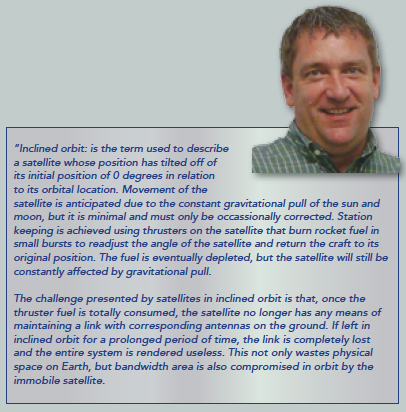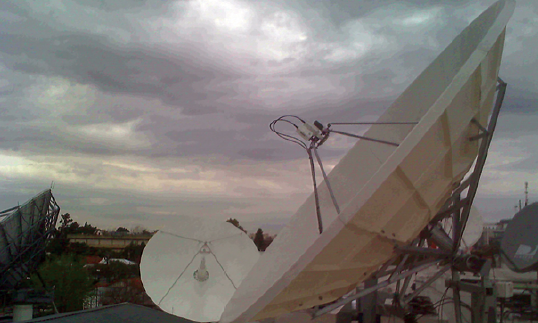In a world that is constantly in motion, industries must find ways to accommodate the adaptation of obsolete products as well as the introduction of new, more advanced products.

The SATCOM industry is no exception. One particular challenge faced by satellite equipment manufacturers, distributors, and consumers alike is a satellite’s decay into inclined orbit. This inevitable obstacle is brought on by the constant force of gravity on the satellite, which subsequently pulls it from its geo-stationary orbit over the course of time.
Satellites possess a station keeping ability that uses engines to return the satellite to its geo-stationary orbit as it is shifted by gravitational pull. The engine’s thrust corrects the angle of inclination so that it remains as close to 0 as possible. However, the fuel used to support this process is a finite resource and will eventually be depleted. Once all of the remaining fuel has burned up, the satellite no longer has the capacity to correct itself and decays into inclined orbit.
The link will not disconnect immediately. Rather, the signal quality will fluctuate, increasing when the angle of the satellite is favorable and decreasing when it is not. A satellite forced into inclined orbit for an extended period of time will completely lose its link connection and be rendered useless.
The decay into inclined orbit has been a constant challenge for the SATCOM industry, as all satellites eventually lose station keeping and fixed antennas lose their links to their satellites. Without intervention, the communication link remains unresponsive—wasting resources, physical space, and limiting usable bandwidth.
The solution to this industry-wide hurdle can be implemented in various ways, but the premise of the answer is simple: mobility. At the core of the hindrance, there is also an advantage. If satellite antenna movement interrupts an antenna’s connection to the satellite, a corresponding movement from the antenna on the ground will correct it.
This can be achieved through two separate methods. A new, motorized antenna can be installed in place of a fixed system, or the existing fixed antenna can be upgraded with a motorized mount. This provides the system with the Azimuth and Elevation movement necessary to maintain its link, tracking a satellite that is physically moving so that the link will never be lost. Both new and upgraded systems effectively track the moving satellites, and each carries a distinct advantage.

Installation of a new, motorized antenna ensures that there is no disruption once the system is in operation. Routine inspection will keep the antenna functioning properly and the system will require little to no maintenance. Initial cost is the largest consideration of purchasing a new motorized antenna, as the technology involved in the manufacturing of the system is considerably more complex than that of a fixed antenna.
Upgrading existing systems to Motorized Dual-Axis can significantly reduce the initial cost, but there are potential hazards. The operator incurs the risk of upgrading an antenna with pre-existing complications, such as physical damage to the reflector or other surfaces. Attached RF equipment can also be compromised and limit the effectiveness of a newly upgraded antenna.
Finally, there are environmental limits that must be considered, such as the growth of trees or other natural obstructions that could hinder the antenna’s movement presently or in the future. These hazards can predominantly be prevented, however, by closely inspecting the condition of the existing fixed antenna system for any indications of potential failure and surveying the field site thoroughly to determine if motorization is possible prior to upgrading.
Currently, there are no alternative solutions for satellites that have fallen into inclined orbit other than manual or remote adjustment. Despite this, the solutions provided by a new motorized system or an upgraded fixed antenna have proven very reliable over the years and offer an exceptional extension to the usefulness and longevity of the antenna. By manufacturing products that adapt to the inevitability of a satellite in inclined orbit, the SATCOM industry is able to maintain the use of previously obsolete systems and develop and incorporate new antennas into a motorized product line. This constant challenge to remain relevant is what makes the SATCOM industry a foundation of world communication. Through innovation, obstacles are overcome and the process of change is forever in motion.
This influx of continual product evolution is further facilitated by the nature of the manufacture and distribution of satellite antenna products and RF accessories. Consumers from various industries all over the globe seek out companies to supply their satellite antenna equipment and their buying preferences are equally diverse.
Over the years, many antenna and RF equipment businesses have become less specialized, increasing their product lines to include a wider range of products to suit many industries, such as broadcasting, military, and disaster relief, as opposed to just a single niche market. This transformation has made the acquisition of equipment for consumers significantly easier. Instead of purchasing products or parts for a motorized system from several specialized vendors, the entire order can be placed with one company. This decreases the possibility of ordering and shipping errors and provides a central contact for technical support when needed.
Viking Satcom has been able to ship customer orders quickly and effectively because of an extensive in-stock product line and experienced technical staff. This structure has proved extremely successful, proving that the SATCOM shift of providing a better customer service experience will no doubt play a huge role in the future of the industry. There are many aspects of the SATCOM industry that are met with the acknowledgement of inevitability. Only one such example is the decay of a satellite into inclined orbit.
However, as new systems are created and old systems are redesigned, solutions are available in the form of innovative motorized antennas and upgrade kits to adapt pre-existing fixed antennas. Both of these options have revolutionized the opportunity for manufacturers, distributors, and customers to have a positive impact and reduce the waste of physical space, resources, and bandwidth area that satellites in inclined orbit inhabit.
As the future of the SATCOM industry itself evolves to further acknowledge the needs of the consumer by providing more products, better service, and an overall positive experience, challenges like inclined orbit satellites will evolve with similarly improved solutions.
For additional information, please visit http://www.vikingsatcom.com/
John Vezmar is the Director of Technology at Viking Satcom and has been in the SATCOM industry for the last 19 years. He is responsible for a variety of successful antenna and accessory designs and currently holds seven
U.S. patents.


